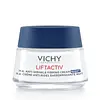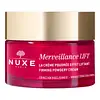What's inside
What's inside
 Key Ingredients
Key Ingredients

 Benefits
Benefits

 Concerns
Concerns

 Ingredients Side-by-side
Ingredients Side-by-side

Water
Skin ConditioningGlycerin
HumectantRhamnose
HumectantPrunus Armeniaca Kernel Oil
MaskingCaprylic/Capric Triglyceride
MaskingPentaerythrityl Tetraethylhexanoate
EmollientCetyl Alcohol
EmollientZea Mays Starch
AbsorbentButyrospermum Parkii Butter
Skin ConditioningPetrolatum
EmollientGlyceryl Stearate
EmollientPentylene Glycol
Skin ConditioningDimethicone
EmollientPEG-40 Stearate
EmulsifyingCera Alba
EmollientHydroxyethylpiperazine Ethane Sulfonic Acid
BufferingAdenosine
Skin ConditioningPentaerythrityl Tetra-Di-T-Butyl Hydroxyhydrocinnamate
AntioxidantSodium Hyaluronate
HumectantTriethanolamine
BufferingAscorbyl Glucoside
AntioxidantMagnesium Ascorbyl Phosphate
AntioxidantCaprylyl Glycol
EmollientCitric Acid
BufferingPoloxamer 338
EmulsifyingSorbitan Tristearate
EmulsifyingXanthan Gum
EmulsifyingDimethiconol
EmollientPhenoxyethanol
PreservativeParfum
MaskingWater, Glycerin, Rhamnose, Prunus Armeniaca Kernel Oil, Caprylic/Capric Triglyceride, Pentaerythrityl Tetraethylhexanoate, Cetyl Alcohol, Zea Mays Starch, Butyrospermum Parkii Butter, Petrolatum, Glyceryl Stearate, Pentylene Glycol, Dimethicone, PEG-40 Stearate, Cera Alba, Hydroxyethylpiperazine Ethane Sulfonic Acid, Adenosine, Pentaerythrityl Tetra-Di-T-Butyl Hydroxyhydrocinnamate, Sodium Hyaluronate, Triethanolamine, Ascorbyl Glucoside, Magnesium Ascorbyl Phosphate, Caprylyl Glycol, Citric Acid, Poloxamer 338, Sorbitan Tristearate, Xanthan Gum, Dimethiconol, Phenoxyethanol, Parfum
Water
Skin ConditioningSqualane
EmollientGlycerin
Humectant2,3-Butanediol
HumectantMacadamia Integrifolia Seed Oil
Skin ConditioningSodium Polyacrylate
AbsorbentArachidyl Alcohol
EmollientCetearyl Alcohol
EmollientBehenyl Alcohol
EmollientParfum
MaskingEthylhexylglycerin
Skin ConditioningArachidyl Glucoside
EmulsifyingPhenethyl Alcohol
MaskingSodium Stearoyl Glutamate
CleansingSodium Gluconate
Skin ConditioningCaprylic/Capric Triglyceride
MaskingHelianthus Annuus Seed Oil
EmollientAlthaea Officinalis Root Extract
Skin ConditioningUndaria Pinnatifida Extract
Skin ConditioningSodium Hydroxide
BufferingBenzyl Alcohol
PerfumingChlorella Vulgaris Extract
Skin ConditioningAcetyl Tetrapeptide-5
HumectantDehydroacetic Acid
PreservativeRosmarinus Officinalis Leaf Extract
AntimicrobialLinalool
PerfumingAlpha-Isomethyl Ionone
PerfumingGeraniol
PerfumingCitronellol
PerfumingLimonene
PerfumingWater, Squalane, Glycerin, 2,3-Butanediol, Macadamia Integrifolia Seed Oil, Sodium Polyacrylate, Arachidyl Alcohol, Cetearyl Alcohol, Behenyl Alcohol, Parfum, Ethylhexylglycerin, Arachidyl Glucoside, Phenethyl Alcohol, Sodium Stearoyl Glutamate, Sodium Gluconate, Caprylic/Capric Triglyceride, Helianthus Annuus Seed Oil, Althaea Officinalis Root Extract, Undaria Pinnatifida Extract, Sodium Hydroxide, Benzyl Alcohol, Chlorella Vulgaris Extract, Acetyl Tetrapeptide-5, Dehydroacetic Acid, Rosmarinus Officinalis Leaf Extract, Linalool, Alpha-Isomethyl Ionone, Geraniol, Citronellol, Limonene
Ingredients Explained
These ingredients are found in both products.
Ingredients higher up in an ingredient list are typically present in a larger amount.
This ingredient is an emollient, solvent, and texture enhancer. It is considered a skin-softener by helping the skin prevent moisture loss.
It helps thicken a product's formula and makes it easier to spread by dissolving clumping compounds.
Caprylic Triglyceride is made by combining glycerin with coconut oil, forming a clear liquid.
While there is an assumption Caprylic Triglyceride can clog pores due to it being derived from coconut oil, there is no research supporting this.
Learn more about Caprylic/Capric TriglycerideGlycerin is already naturally found in your skin. It helps moisturize and protect your skin.
A study from 2016 found glycerin to be more effective as a humectant than AHAs and hyaluronic acid.
As a humectant, it helps the skin stay hydrated by pulling moisture to your skin. The low molecular weight of glycerin allows it to pull moisture into the deeper layers of your skin.
Hydrated skin improves your skin barrier; Your skin barrier helps protect against irritants and bacteria.
Glycerin has also been found to have antimicrobial and antiviral properties. Due to these properties, glycerin is often used in wound and burn treatments.
In cosmetics, glycerin is usually derived from plants such as soybean or palm. However, it can also be sourced from animals, such as tallow or animal fat.
This ingredient is organic, colorless, odorless, and non-toxic.
Glycerin is the name for this ingredient in American English. British English uses Glycerol/Glycerine.
Learn more about GlycerinParfum is a catch-all term for an ingredient or more that is used to give a scent to products.
Also called "fragrance", this ingredient can be a blend of hundreds of chemicals or plant oils. This means every product with "fragrance" or "parfum" in the ingredients list is a different mixture.
For instance, Habanolide is a proprietary trade name for a specific aroma chemical. When used as a fragrance ingredient in cosmetics, most aroma chemicals fall under the broad labeling category of “FRAGRANCE” or “PARFUM” according to EU and US regulations.
The term 'parfum' or 'fragrance' is not regulated in many countries. In many cases, it is up to the brand to define this term.
For instance, many brands choose to label themselves as "fragrance-free" because they are not using synthetic fragrances. However, their products may still contain ingredients such as essential oils that are considered a fragrance by INCI standards.
One example is Calendula flower extract. Calendula is an essential oil that still imparts a scent or 'fragrance'.
Depending on the blend, the ingredients in the mixture can cause allergies and sensitivities on the skin. Some ingredients that are known EU allergens include linalool and citronellol.
Parfum can also be used to mask or cover an unpleasant scent.
The bottom line is: not all fragrances/parfum/ingredients are created equally. If you are worried about fragrances, we recommend taking a closer look at an ingredient. And of course, we always recommend speaking with a professional.
Learn more about ParfumWater. It's the most common cosmetic ingredient of all. You'll usually see it at the top of ingredient lists, meaning that it makes up the largest part of the product.
So why is it so popular? Water most often acts as a solvent - this means that it helps dissolve other ingredients into the formulation.
You'll also recognize water as that liquid we all need to stay alive. If you see this, drink a glass of water. Stay hydrated!
Learn more about Water